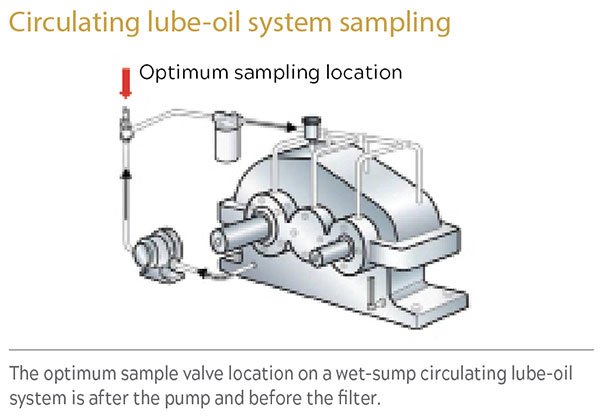Sampling Key To Oil Analysis
EP Editorial Staff | March 1, 2023
Where and how you acquire oil samples determines what an analysis says about your assets.
By Mark Barnes, PhD CMRP, Des-Case Corp.
For oil-critical lubricated assets, oil analysis is a vital condition-monitoring tool that provides meaningful information, not just about the health and condition of the lubricant but also the degree to which the fluid is contaminated, or active wear is occurring. Like any other diagnostic technique where data is based on a measurement or physical sample, the key to oil analysis is ensuring that the sample location delivers oil that is representative of the machine and, in particular, the issues being addressed.
Non-circulating systems
Sampling location becomes rather critical when monitoring wear debris or contamination. For wet-sump non-circulating components, such as pumps and splash-lubricated gearboxes, sampling location is easy. The only way to take a sample is to extract it from the wet sump. Most wet-sump systems are sampled using the “drop-tube” method where a thin, 1/4-in. (6-mm) plastic tube is inserted through the fill port or other access point and the oil extracted using a vacuum oil-sampling gun.
While this is by far the most common method, the technique can create a significant degree of sample variability since we can never be certain that the end of the sampling tube is in the optimum location each time. Contamination and, in particular, wear debris will be present in different concentrations from the top to the bottom of the oil level, as well as close to or far from rotating assemblies that may be wearing.
For this reason, any wet-sump non-circulating system should be set up with a dedicated oil sample valve, often referred to as a pitot tube. It should be permanently installed in a convenient access point and the tube bent to ensure that the end of the tube is 2 in. (5 cm) in from the walls, the bottom of the sump, and any rotating assemblies.
Circulating systems
For wet-sump, force-fed oil-circulation systems, extracting a sample becomes easier since the oil is under low pressure. As such, we can use system pressure to extract an oil sample by installing a low-pressure sample valve in the circulating lube lines. For wet-sump circulating systems, the ideal sampling location is after the oil pump and before the oil filter. By locating the sample valve immediately after the oil pump, the sample will pick up evidence of active pump wear, as well as component wear inside the wet sump. While the oil pump may be the least costly and problematic to replace, if it were to fail, the more expensive components inside the wet sump would fail quickly when they become starved of oil. The sample port should always be located upstream of the filter since the filter will remove evidence of active wear and may provide a false sense of security around oil cleanliness.
Dry-sump circulating systems usually contain the largest quantity of oil. These oil volumes can quickly render oil analysis ineffective.
Many of the tests we perform on oil samples measure the concentrations of wear debris or contaminants. Larger oil volumes can dilute wear debris below the detectable limits of oil-analysis instrumentation, while contamination levels will be strongly influenced by where the sample is taken, relative to the point of contamination ingress and the location of oil filters. For this reason, reservoir sampling should be avoided when measuring wear and contamination.
Dry-sump circulating systems should be sampled from the return line, downstream from oil-lubricated components. For hydraulic systems, which often contain return-line filters, the sample point should be located upstream of the filter.
Note that return-line sampling a hydraulic or other circulating lube-oil system can be ineffective when oil from a large number of return lines combines into a single return line. Just like reservoir sampling, this will dilute contaminants and wear debris.
For greatest impact, dry-sump circulating systems should ideally be set up with multiple sample points that can be used to measure wear, contamination, and oil health. For oil health, install a sample point at the mid-point in the oil reservoir, purely for measuring oil condition. A second set of sample valves should be located immediately downstream of pumps and bearings. This location will be the most effective at detecting active machine wear. While not practical for systems with lots of bearings, such as paper machine lube-oil systems, for systems such as turbo-compressors and steam turbines, which may have four to six bearings, this is a reasonable proposition, given that these larger systems are often critical assets.
For hydraulic systems, where contamination is often the leading cause of failure, sampling immediately downstream of the most common points of ingression provides the most effective location for contamination monitoring. This allows quick identification of seal failure or internal component wear from the actuators such as cylinders and hydraulic drives. Sampling on the supply line, after the main full-flow filters but before the valve block, may also be desired to ensure that the oil flowing to the most contamination-sensitive components—the valves—can be measured. While this may seem like a lot of samples and additional-oil analysis cost, consider the cost of not taking the sample from the right location and missing a catastrophic failure.
Like its condition-monitoring cousin vibration analysis, oil analysis is an effective predictive and proactive tool. Pay attention to sampling location. As the old adage goes, “Garbage in, garbage out.” EP
Mark Barnes, PhD CMRP, is Senior Vice President, Global Business Development, at Des-Case Corp., Goodlettsville, TN (descase.com). He has more than 25 years of experience in lubrication management, oil analysis, and contamination control.











View Comments